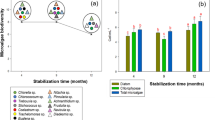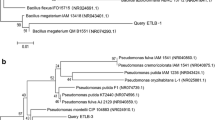Abstract
This study utilized Penicillium spp. to treat mature landfill leachate (MLL) in a continuous bioreactor and batch experimental tests under non-sterile conditions. MLL characteristics such as chemical oxygen demand (COD), soluble COD (sCOD), total carbon (TC), total organic carbon (TOC), and color removal efficiency were determined. The lignocellulosic enzymatic activity of laccase (Lac), lignin-peroxidase (LiP), and manganese-peroxidase (MnP) was also determined. The batch experimental test was carried out with raw and pretreated MLL containing the initial NH4+–N concentrations of 0, 105, 352, and 914 mg/L. A maximum COD reduction of 41% and maximum enzymatic activity of 193, 37, and 25 U/L for Lac, LiP and MnP was recorded for the MLL containing 352 mg/L NH4+–N. The continuous bioreactor exhibited maximum values of 52, 54, 60, 58, and 75 percentage of COD, sCOD, TC, TOC, and color removal efficiency with MLL containing 352 mg/L NH4+–N that was pretreated at HRT 120 h, while the maximum detected lignocellulosic enzymatic activities were 149, 27, and 16 U/L for Lac, LiP, and MnP, respectively. A total of 64% COD reduction was achieved from the raw MLL considering 12% COD and 100% NH4+–N reduction in the aerobic activated sludge sequencing batch reactor pretreatment process. The steady and higher removal efficiency of the bioreactor over the entire study period is promising for further exploration to enhance removal of refractory contaminants from the MLL.





Similar content being viewed by others
Availability of data and material
The datasets used and/or analysed during the current study are available from the corresponding author on reasonable request.
Abbreviations
- ANOVA:
-
Analysis of variance
- BOD:
-
Biochemical oxygen demand
- BRRMF:
-
Brady road resource management facility
- Ca:
-
Calcium
- COD:
-
Chemical oxygen demand
- CT:
-
Control
- F:
-
Fungus
- Fe:
-
Iron
- h:
-
Hour
- HRT:
-
Hydraulic retention time
- K:
-
Potassium
- L:
-
Liter
- Lac:
-
Laccase
- LiP:
-
Ligni-peroxidase
- mg:
-
Milligram
- Mg:
-
Magnesium
- MLL:
-
Mature landfill leachate
- MLTSS:
-
Mix liquor total suspended solids
- MLVSS:
-
Mix liquor volatile suspended solid
- mM:
-
Millimolar
- Mn:
-
Manganese
- MnP:
-
Manganese-peroxidase
- N:
-
Nitrogen
- Na:
-
Sodium
- nm:
-
Nanometer
- P:
-
Phosphorus
- pCOD:
-
Particulate chemical oxygen demand
- PUF:
-
Polyethylene foam
- rpm:
-
Revolution per minute
- SBR:
-
Sequencing batch reactor
- sCOD:
-
Soluble chemical oxygen demand
- SVI:
-
Sludge volume index
- TC:
-
Total carbon
- TN:
-
Total nitrogen
- TOC:
-
Total organic carbon
- U/L:
-
Unit per liter
- v/v:
-
Volume / volume
- VSS:
-
Volatile suspended solids
- WWTP:
-
Wastewater treatment plant
References
Berenjkar P, Islam M, Yuan Q. Co-treatment of sewage sludge and mature landfill leachate by anaerobic digestion. Int J Environ Sci Technol. 2018;1:2465–74. https://doi.org/10.1007/s13762-018-1889-2.
Foo KY, Hameed BH. An overview of landfill leachate treatment via activated carbon adsorption process. J Hazard Mater. 2009;171:54–60. https://doi.org/10.1016/j.jhazmat.2009.06.038.
Mandal P, Dubey BK, Gupta AK. Review on landfill leachate treatment by electrochemical oxidation: drawbacks, challenges and future scope. Waste Manag. 2017;69:250–73. https://doi.org/10.1016/J.WASMAN.2017.08.034.
Peyravi M, Jahanshahi M, Alimoradi M, Ganjian E. Old landfill leachate treatment through multistage process: membrane adsorption bioreactor and nanofitration. Bioprocess Biosyst Eng. 2016;39:1803–16. https://doi.org/10.1007/s00449-016-1655-0.
Saleem M, Spagni A, Alibardi L, Bertucco A, Lavagnolo MC. Assessment of dynamic membrane filtration for biological treatment of old landfill leachate. J Environ Manag. 2018;213:27–35. https://doi.org/10.1016/j.jenvman.2018.02.057.
Ren Y. Evaluation of landfill leachate treatment using aerobic granular sludge and activated sludge processes: University of Manitoba; 2017.
Torretta V, Ferronato N, Katsoyiannis I, Tolkou A, Airoldi M. Novel and conventional technologies for landfill leachates treatment: a review. Sustainability. 2016;9:9. https://doi.org/10.3390/su9010009.
Ghosh P, Swati T. Enhanced removal of COD and color from landfill leachate in a sequential bioreactor. Bioresour Technol. 2014;170:10–9. https://doi.org/10.1016/j.biortech.2014.07.079.
Islam M, Yuan Q. Emerging concern of micropollutants: recommended inclusion of antibiotics monitoring in the environmental effects monitoring program for municipal wastewater effluents. Int J Environ Sci Dev. 2019;10:399–403. https://doi.org/10.18178/ijesd.2019.10.11.1206.
Sardrood BP, Goltapeh EM, Varma A. An introduction to bioremediation. In: An introduction to bioremediation. Berlin, Heidelberg: Springer; 2013. p. 3–27. https://doi.org/10.1007/978-3-642-33811-3_1.
Ochoa FG, Gomez E. Bioreactor scale-up and oxygen transfer rate in microbial processes: an overview. Biotechnol Adv. 2008;27:153–76. https://doi.org/10.1016/j.biotechadv.2008.10.006.
Sodaneath H, Lee J-I, Yang S-O, Jung H, Ryu HW, Cho K-S. Decolorization of textile dyes in an air-lift bioreactor inoculated with Bjerkandera adusta OBR105. J. Environ. Sci. Heal. Part A. 2017;52:1099–111. https://doi.org/10.1080/10934529.2017.1340753.
Papagianni M. Fungal morphology and metabolite production in submerged mycelial processes. Biotechnol Adv. 2004;22:189–259. https://doi.org/10.1016/J.BIOTECHADV.2003.09.005.
Tang Y-J, Zhang W, Liu R-S, Zhu L-W, Zhong J-J. Scale-up study on the fed-batch fermentation of Ganoderma lucidum for the hyperproduction of ganoderic acid and Ganoderma polysaccharides. Process Biochem. 2011;46:404–8. https://doi.org/10.1016/J.PROCBIO.2010.08.013.
Nair RB, Lennartsson PR, Taherzadeh MJ. Mycelial pellet formation by edible ascomycete filamentous fungi, Neurospora intermedia. AMB Express. 2016;6:31. https://doi.org/10.1186/s13568-016-0203-2.
Kalčíková G, Babič J, Pavko A, Gotvajn AŽ. Fungal and enzymatic treatment of mature municipal landfill leachate. Waste Manag. 2014;34:798–803. https://doi.org/10.1016/j.wasman.2013.12.017.
Saetang J, Babel S. Effect of leachate loading rate and incubation period on the treatment efficiency by T. versicolor immobilized on foam cubes. Int J Environ Sci Technol. 2009;6:457–66. https://doi.org/10.1007/BF03326085.
Bardi A, Yuan Q, Siracusa G, Chicca I, Islam M, Spennati F, et al. Effect of cellulose as co-substrate on old landfill leachate treatment using white-rot fungi. Bioresour Technol. 2017;241:1067–76. https://doi.org/10.1016/j.biortech.2017.06.046.
Islam M, Wai A, Hausner G, Yuan Q. Effect of lignocellulosic enzymes on the treatment of mature landfill leachate. J Environ Manag. 2019;233:400–9. https://doi.org/10.1016/j.jenvman.2018.12.045.
Chen SH, Yien Ting AS. Biosorption and biodegradation potential of triphenylmethane dyes by newly discovered Penicillium simplicissimum isolated from indoor wastewater sample. Int Biodeterior Biodegradation. 2015;103:1–7. https://doi.org/10.1016/j.ibiod.2015.04.004.
Govarthanan M, Fuzisawa S, Hosogai T, Chang Y-C. Biodegradation of aliphatic and aromatic hydrocarbons using the filamentous fungus Penicillium sp. CHY-2 and characterization of its manganese peroxidase activity. RSC Adv. 2017;7:20716–23. https://doi.org/10.1039/C6RA28687A.
Li G, Chen J, Yan W, Sang N. A comparison of the toxicity of landfill leachate exposure at the seed soaking and germination stages on Zea mays L. (maize). J Environ Sci. 2017a;55:206–13. https://doi.org/10.1016/j.jes.2016.06.031.
Svobodová K, Novotný Č. Bioreactors based on immobilized fungi: bioremediation under non-sterile conditions. Appl Microbiol Biotechnol. 2018;102:39–46. https://doi.org/10.1007/s00253-017-8575-z.
M.N, Chavan, N.D, Dandi, M. V, Kulkarni, A.B, Chaudhari, 2013. Biotreatment of melanoidin-containing distillery spent wash effluent by free and immobilized Aspergillus oryzae MTCC 7691. Water, air, soil Pollut. 224, 1755. https://doi.org/10.1007/s11270-013-1755-2.
Ellouze M, Aloui F, Sayadi S. Effect of high ammonia concentrations on fungal treatment of Tunisian landfill leachates. Desalination. 2009;246:468–77. https://doi.org/10.1016/j.desal.2008.03.068.
Koshy L, Paris E, Ling S, Jones T, BéruBé K. Bioreactivity of leachate from municipal solid waste landfills - assessment of toxicity. Sci Total Environ. 2007;384:171–81. https://doi.org/10.1016/j.scitotenv.2007.06.017.
Li X, Li F, Lai C, Huang J, Pang Y, Luo K, et al. Activities of laccase produced by a strains Penicillium simplicissimum induced by chemical agentia and UV radiation. J Cent South Univ. 2017b;24:1953–8. https://doi.org/10.1007/s11771-017-3603-9.
Ahmed FN, Lan CQ. Treatment of landfill leachate using membrane bioreactors: a review. Desalination. 2012;287:41–54. https://doi.org/10.1016/j.desal.2011.12.012.
Zhang J, Yang T, Wang H, Yang K, Fang C, Lv B, et al. Study on treating old landfill leachate by ultrasound–Fenton oxidation combined with MAP chemical precipitation. Chem Speciat Bioavailab. 2015;27:175–82. https://doi.org/10.1080/09542299.2015.1118360.
APHA. Standard methods for the examination of water and wastewater. 18th ed. DC, USA.: American Public Health Association (APHA), American Water Works Association (AWWA), Water Environment Federation (WEF), Washington; 1998.
Bourbonnais R, Paice MG. Oxidation of non-phenolic substrates. FEBS Lett. 1990;267:99–102. https://doi.org/10.1016/0014-5793(90)80298-W.
Vyas BRM, Volc J, Šašek V. Ligninolytic enzymes of selected white rot fungi cultivated on wheat straw. Folia Microbiologia (Praha). 1994;39:235–40. https://doi.org/10.1007/BF02814655.
Tien M, Kirk TK. Lignin-degrading enzyme from Phanerochaete chrysosporium : purification, characterization, and catalytic properties of a unique H2O2-requiring oxygenase. Proc Natl Acad Sci. 1984;81:2280–4. https://doi.org/10.1073/pnas.81.8.2280.
Manitoba Water Stewardship. Manitoba water quality standards, objectives, and guidelines. MB, Canada: Winnipeg; 2011.
Ürek RÖ, Pazarlioǧlu NK. Production and stimulation of manganese peroxidase by immobilized Phanerochaete chrysosporium. Process Biochem. 2005;40:83–7. https://doi.org/10.1016/j.procbio.2003.11.040.
Singh D, Chen S. The white-rot fungus Phanerochaete chrysosporium: conditions for the production of lignin-degrading enzymes. Appl Microbiol Biotechnol. 2008;81:399–417. https://doi.org/10.1007/s00253-008-1706-9.
Tchobanoglous G, Burton FL, Stensel HD. Wastewater engineering: treatment and reuse. 4th ed. Boston, MA, USA: McGraw-Hill; 2013.
Xu Z-Y, Zeng G-M, Yang Z-H, Xiao Y, Cao M, Sun H-S, et al. Biological treatment of landfill leachate with the integration of partial nitrification, anaerobic ammonium oxidation and heterotrophic denitrification. Bioresour Technol. 2010;101:79–86. https://doi.org/10.1016/j.biortech.2009.07.082.
Wang Y, Pelkonen M, Kaila J. Cost-saving biological nitrogen removal from strong ammonia landfill leachate. Waste Manag Res. 2011;29:797–806. https://doi.org/10.1177/0734242X10394911.
Marañón E, Castrillón L, Fernández-Nava Y, Fernández-Méndez A, Fernández-Sánchez A. Colour, turbidity and COD removal from old landfill leachate by coagulation-flocculation treatment. Waste Manag Res. 2010;28:731–7. https://doi.org/10.1177/0734242X09352504.
Müller GT, Giacobbo A, dos Santos Chiaramonte EA, Rodrigues MAS, Meneguzzi A, Bernardes AM. The effect of sanitary landfill leachate aging on the biological treatment and assessment of photoelectrooxidation as a pre-treatment process. Waste Manag. 2015;36:177–83. https://doi.org/10.1016/j.wasman.2014.10.024.
Kaushik G, Gopal M, Thakur IS. Evaluation of performance and community dynamics of microorganisms during treatment of distillery spent wash in a three stage bioreactor. Bioresour Technol. 2010;101:4296–305. https://doi.org/10.1016/j.biortech.2010.01.046.
Lu X-M, Ma L-H, Wang Z-H, Huang M-S. Application of polymerase chain reaction–denaturing gradient gel electrophoresis to resolve taxonomic diversity in white rot fungus reactors. Environ Eng Sci. 2010;27:493–503. https://doi.org/10.1089/ees.2010.0007.
Acknowledgements
The authors acknowledge the input of Dr. Munz and Dr. Spennati from University of Florence, Dr. Bardi from University of Pisz to develop the idea of fungal bioreactor.
Funding
The financial support was appropriated to the Graduate Enhancement of Tri-Council Stipends (GETS) and Create-H2O programs, University of Manitoba for this research from the Natural Sciences and Engineering Research Council of Canada (NSERC).
Author information
Authors and Affiliations
Contributions
Mr. Mofizul Islam performed the overall entire experimental study including experimental design, reactors operation, samples collection and analysis, data interpretation, and manuscript writing. Mr. Qian Xu contributed to design and operating of the aerobic activated sludge bioreactor. Dr. Qiuyan Yuan supervised all aspects of the experimental study and contributed to improve the writing of the manuscript.
Corresponding author
Ethics declarations
Ethics approval and consent to participate
Not applicable.
Consent for publication
Not applicable.
Competing interests
The authors declare that they have no competing interests.
Additional information
Publisher’s note
Springer Nature remains neutral with regard to jurisdictional claims in published maps and institutional affiliations.
Electronic supplementary material
ESM 1
(DOCX 27 kb)
Rights and permissions
About this article
Cite this article
Islam, M., Xu, Q. & Yuan, Q. Advanced biological sequential treatment of mature landfill leachate using aerobic activated sludge SBR and fungal bioreactor. J Environ Health Sci Engineer 18, 285–295 (2020). https://doi.org/10.1007/s40201-020-00466-z
Received:
Accepted:
Published:
Issue Date:
DOI: https://doi.org/10.1007/s40201-020-00466-z




